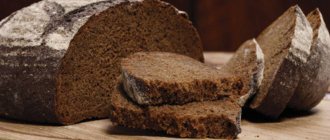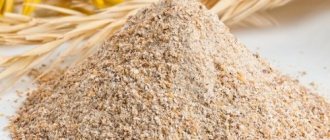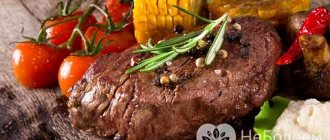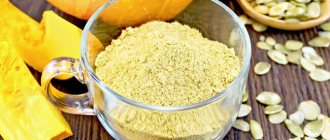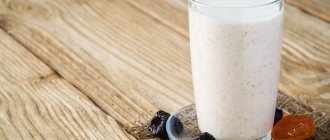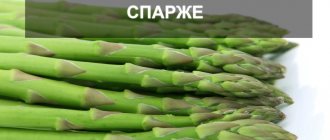Composition and benefits
Rye bread is one of the types of bakery products. It is valued not only for its taste, but also for its benefits to the human body. It is most in demand in Northern Europe, the Russian Federation and the countries of the former CIS.
The composition of regular rye bread includes:
- leaven,
- Rye flour,
- water,
- salt.
Rye bread is a storehouse of vitamins and beneficial microelements
Foreign and domestic manufacturers have diluted the standard rye bread recipe with their own additives. Additional ingredients include alternative flours, seeds, nuts, plant seeds and colorings.
What are the benefits of rye flour:
As a result, the following varieties of rye bread can be distinguished:
- from peeled flour,
- from wallpaper flour,
- from sifted flour,
- with the addition of wheat flour,
- sourdough rye bread.
You can also find baked rye bread on store shelves. It differs from the simplest rye in that it is made from a higher quality variety of rye flour. This type of bread is considered healthier than regular bread. It includes:
- liquid yeast,
- premium wheat flour,
- sifted rye flour,
- sugar,
- salt,
- water.
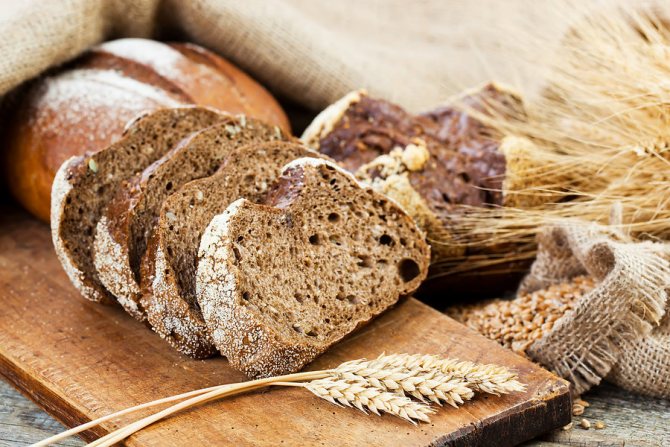
Rye bread made from pecked flour is characterized by high quality
Bread contains many vitamins and beneficial microelements that are so necessary for humans. But despite such a valuable composition and benefits, many choose baked goods made from wheat flour. Perhaps long-established stereotypes that white bread is for the nobility and gray bread for the poor are responsible for this. Nowadays, there are more and more supporters of healthy eating who prefer rye. They combine bread with meat dishes and vegetables, and many people love its sweet and sour taste.
Six to seven slices of bread can provide the human body with half the daily requirement of vitamins and beneficial microelements. A huge difference in composition and beneficial properties can be seen when comparing rye bread with wheat bread.
Table: calorie content and chemical composition of rye and wheat bread (100 g)
| Name | Quantity (for rye bread) | Quantity (for wheat bread) |
| Calorie content per 100 g of product | 259 kcal | 270 kcal |
| Squirrels | 6.6 g | 8.1 g |
| Fats | 1.2 g | 1 g |
| Carbohydrates | 34.2 g | 48.8 g |
| Vitamins | ||
| Vitamin PP | 0.7 mg | 1.6 mg |
| Vitamin E | 2.2 mg | |
| Beta carotene | 0.006 mg | |
| Vitamin A | 1 mcg | |
| Vitamin B1 | 0.18 mg | 0.16 mg |
| Vitamin B2 | 0.08 mg | 0.06 mg |
| Vitamin B5 | 0.6 mg | 0.29 mg |
| Vitamin B6 | 0.17 mg | 0.13 mg |
| Vitamin B9 | 30 mcg | 27 mcg |
| Vitamin E (TE) | 1.4 mg | 1.3 mg |
| Vitamin H | 1.7 mcg | 1.7 mcg |
| Vitamin PP (NOT) | 2 mg | 3.1 mg |
| Kholin | 60 mg | 54 mg |
| Minerals | ||
| Iron | 3.9 mg | 2 mg |
| Zinc | 1.21 mg | 0.735 mg |
| Iodine | 5.6 mcg | 3.2 mcg |
| Copper | 220 mg | 134 mg |
| Manganese | 1.6 mg | 0.825 mg |
| Selenium | 5 mcg | 6 mcg |
| Chromium | 2.7 mcg | 2.2 mcg |
| Fluorine | 35 mcg | 14.5 mcg |
| Molybdenum | 8 mcg | 12.8 mcg |
| Bor | 23 mcg | 48 mcg |
| Vanadium | 40 mcg | 66 mcg |
| Silicon | 7 mcg | 2.2 mg |
| Cobalt | 2 mg | 1.9 mcg |
| Sulfur | 52 mg | 59 mg |
| Chlorine | 980 mg | 837 mg |
| Phosphorus | 158 mg | 87 mg |
| Potassium | 245 mg | 133 mg |
| Sodium | 610 mg | 378 mg |
| Magnesium | 47 mg | 33 mg |
| Calcium | 35 mg | 23 mg |
Video: why rye bread is better than wheat bread
Beneficial features
Based on the composition of rye bread, we can conclude that it is of undoubted value in the daily diet. But not every loaf of bread has a beneficial effect. Often the beneficial substances are removed during the milling and refining of the flour, leaving the bread “empty” and useless. That's why it's so important to choose it wisely. It is best to buy bread made from wallpaper flour (coarsely ground), whole grain or with added bran.
The benefits and harms of sunflower seeds:
The method of preparing the dough is also important. Bread made with sourdough is especially valuable, as it enriches it with lactic acid bacteria, which are so necessary for our intestines.
The main positive qualities of rye bread:
- contains a large amount of vitamins and essential amino acids;
- is a source of fiber (solid indigestible fibers that cleanse the body);
- helps remove toxins and waste;
- helps eliminate constipation;
- prevents dysbacteriosis;
- gives a quick feeling of fullness with the same amount as wheat bread;
- recommended for dietary purposes;
- used for the prevention of cardiovascular diseases;
- recommended for diabetes;
- used for the prevention of cancer;
- accelerates metabolic processes in the body;
- restores hemoglobin levels;
- helps reduce cholesterol levels and remove excess cholesterol;
- recommended for anemia;
- recommended for pregnant women;
- contains one and a half times more iron and 50% more magnesium and potassium than bread made from wheat flour;
- used for the prevention of gastrointestinal diseases.
The greatest benefit from bread can be obtained in the first 36 hours after it is prepared. Then its valuable properties will rapidly decline.
Selection rules
To select a high-quality product on store shelves, you must first decide on the type of product. A pure rye product is not suitable for everyone, so most people opt for the rye-wheat variety.
An important role in choosing a product is played by taste, namely, various types of additives. Having chosen the most suitable type of product, it is advisable to inspect the appearance of the baked goods for defects or color changes, which indicate the degree of baking of the product.
How long does rye bread remain usable? The package label contains this important information. It shows the date of manufacture, shelf life, composition, calorie content and nutritional value. The residence time of bread in stores ranges from 24 to 36 hours from the moment of baking.
Are there any contraindications and is there any possible harm from eating rye bread?
In addition to its benefits, bread with rye flour has contraindications, and if consumed incorrectly, it can begin to negatively affect the human body. It is worth paying attention to the fact that he:
- may worsen the condition of people suffering from high stomach acidity;
- not recommended for stomach ulcers;
- is less easily absorbed and digested compared to wheat bread;
- contraindicated for liver inflammation;
- worsens the condition of people suffering from gallbladder diseases;
- not recommended for use with colic;
- not recommended for duodenal ulcers;
- in large quantities leads to flatulence and digestive disorders;
- if used incorrectly, it leads to weight gain;
- may contain carcinogens, as some manufacturers add flavorings and preservatives to it;
- contraindicated in the postoperative period;
- aggravates the condition of those who have an inflamed esophagus;
- harms people with gluten intolerance;
- not recommended for enterocolitis.
To reduce the adverse effects of rye bread on the human body, manufacturers add wheat flour to the recipe. As a result, rye bread contains 85% rye flour and 25% wheat flour.
Additional ingredients added by the manufacturer
Often manufacturers decide to introduce an additional product with the composition of rye-wheat bread.
Such additional additives may be:
- sodium propionate or E 280 – preservative;
- sulfur dioxide (E 220) – a powerful preservative, used against mold;
- E 330 – citric acid, it is an acid regulator;
- sorbic acid is a relatively harmless preservative;
- emulsifiers are substances that improve the condition of the dough.
All these additives are carried out with the aim of giving baked goods a certain aroma, which will be a distinctive feature of this type of product. Buyers will thus remember its unique taste and aroma and will purchase the product on an ongoing basis.
Daily consumption rates
Adult men and women leading an active lifestyle are recommended to consume 250–350 g of rye bread per day to meet their daily requirement of baked goods. Doctors recommend that people who engage in heavy physical labor eat 500 g of bread. If the main activities every day are intellectual work and a sedentary lifestyle, then 150 g of rye bread is enough to maintain the level of necessary substances.
If the daily diet includes wheat and rye bread, then the amount of rye should be at least 25% of the total norm.
Table: daily consumption rates of rye bread depending on age and energy consumption
| Age | Quantity, g |
| Children under 3 years old | no more than 100 |
| 4–6 years | 150 |
| 7–10 years | 220 |
| 11–13 years old | 300 |
| Teenage girls (14–17 years old) | 300 |
| Teenagers (14–17 years old) | 400 |
| People engaged in manual labor (18–59 years old) | 250–500 |
| Elderly people (over 60 years old) | 150–200 |
History of origin
It was this variety that in those days was designated by the term “bread,” while the names of other bakery products had to be specified (roll, loaf, or white bread).
Since ancient times, the secret recipe for making rye bread has been passed down from generation to generation and carefully guarded. This product has since become traditional in Rus' and was presented on the tables of a wide variety of classes. And even foreign trends in the Middle Ages could not reduce the popularity of native Russian black pastries.
Features of use
Rye bread is indispensable for meat dishes, vegetables, it is popular in the form of toast and croutons. It is valued for its taste, mineral and vitamin composition, but it is important to know how to use rye bread correctly.
Is it possible to get heartburn from rye bread?
Quite often, a small piece of fresh, tasty, aromatic bread leads to heartburn. In most cases, the culprits are problems with the digestive system, which also occur in healthy people. The reason for this is intolerance to certain ingredients in rye bread.
A person produces a lot of saliva when a piece of bread enters his mouth. During the chewing process, it begins to break down. At this time, a lot of gastric juice is formed in the stomach, and the lump of bread arrives there already half split. Thus, the complete processing of the piece will require much less stomach acid than was initially released. Its excess irritates the walls of the stomach and can cause ulcers.
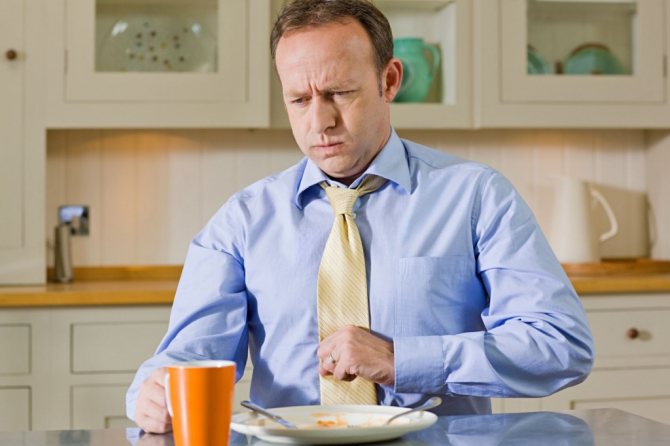
Many components of rye bread can cause heartburn
Not all ingredients in bread are equally healthy. Here are some of its possible ingredients that may cause heartburn:
- Yeast. They help raise the dough and make the bread airy and soft. But when they enter the body with fresh bread, they undergo fermentation and oxidation processes. This is how yeast becomes the culprit of heartburn.
- Pieces of fruit, nuts, seeds, sweets. Seeds and nuts take longer to digest, and sweets (icing, chocolate, etc.) irritate the mucous membrane of the digestive organs.
- Fat (butter or margarine). This mainly applies to homemade baking. Housewives do not skimp on good butter or high-fat margarine. This makes the bread tastier and more aromatic, but it will be harder for the stomach to digest. Because of this, the product stagnates in the body longer and can cause heartburn.
To avoid heartburn, doctors and nutritionists recommend:
- buy not fresh, but yesterday’s bread;
- observe the daily bread allowance;
- eat together with other foods;
- choose black bread with the simplest composition, without additives;
- give preference to unleavened bread;
- cook it at home with low fat ingredients.
Is it possible to have rye bread during pregnancy?
During pregnancy, women often crave rye bread. The reason for this is yeast, which contains a lot of vitamin E. Doctors recommend including this bread in your diet, but without yeast in its composition. It provides energy and causes minimal harm to the child. They are also advised to choose bread with minimal acidity so as not to cause pain in the intestinal area.

To make sure whether you can eat rye bread during pregnancy, you need to consult your doctor.
During pregnancy, it is better to replace bread with other equally healthy products, but you should not give it up completely. You should choose the simplest bread and adhere to the norm for its consumption.
The norm of rye bread for a pregnant woman is 100–150 g per day. Doctors do not recommend exceeding the norm, so as not to harm the child.
In the diet of a nursing mother
As during pregnancy, during breastfeeding, rye bread was and remains much healthier than white bread. It gives energy not only to the mother, but also to the baby. It improves muscle tone, maintains the beauty and elasticity of the skin, and prevents the development of cellulite. But exceeding the consumption limit can harm not only the mother, but also the child. It should be introduced into the diet of a nursing mother little by little and gradually watch the baby’s reaction (behavior, stool, rashes). Pediatricians and nutritionists do not recommend combining it with fatty foods. It is tasty and healthy to eat in dried form.

During breastfeeding, bread improves the health of the mother and gives energy to the baby
Mothers feeding their babies with breast milk should give preference to rye bread with the simplest ingredients, without fillers or additives. Flavorings and additives in the form of fruits, nuts, seeds and sweets can be the main cause of allergies in a baby. They can also worsen the functioning of the mother’s gastrointestinal tract, and this will lead to a decrease in the value of breast milk. When choosing rye bread, adhere to the following rules:
- Do not buy fresh bread, as it leads to constipation for mother and child. You should give preference to day-old bread, as it stimulates digestion.
- Choose a well-baked product. This is checked this way: squeeze the bread, if it is well baked, it will return to its shape, otherwise it will remain deformed.
- The smell of bread should not contain baked goods. This means that it contains dough improvers, which cause an allergic reaction in infants.
- Pay attention to the structure. If the bread is too porous, this is evidence of yeast activators in the composition. They are of no use.
- Buy bread in plastic bags with recent baking dates. Products that have been baked for a long time may contain mold.
Rye bread in a child's diet
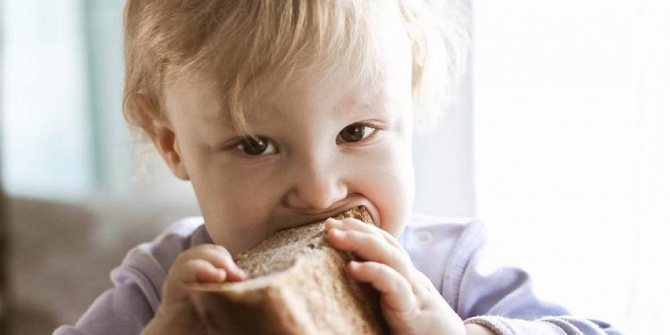
The best time to introduce rye bread into a child’s diet is 3 years.
Pediatricians advise giving bread to babies from 7 months of age in the form of crackers. But rye bread should be introduced into the diet only after 3 years. This is explained by the fact that the enzymes in the child’s digestive system are not yet sufficiently formed and cannot break down the complex components of bread. From the age of 3, bread is given in an amount of 10–15 g. The child’s reaction is observed for a couple of days and if the reaction is normal, the volume is increased to 100 g per day.
Black bread is indeed healthier for an adult. Rye flour contains more B vitamins and iron than wheat flour. Between us, white bread made from premium flour is an unhealthful product. They eat it simply because they eat it. You shouldn't expect much benefit from it. Rye bread contains more fiber. So it is preferable for an adult.
Why it should not be given to small children, especially at 10 months. This is due to the technology of making rye bread. It is made only with sourdough. Plus, rye flour itself has a higher acidity than wheat flour. That is, rye bread is definitely more “sour” than wheat bread. And wetter. Therefore, it is more difficult to digest and is not even recommended for people with high stomach acidity. So I wouldn’t give a child one year old, or even two years old, rye bread. By the way, I don’t give you wheat, and we get by calmly.))
It's up to you, good luck!
Natalia, food technologist
https://www.babyblog.ru/community/post/baby_food/1218614
For what diseases can you include bread in your diet?
Despite its rich composition and beneficial properties, rye bread is not healthy for everyone. This is especially true for people suffering from various ailments. To use it calmly and not be afraid of negative effects, you need to consult a doctor.
For diabetes
Rye bread, in comparison with white bread, does not increase blood sugar levels. Bread with bran is especially valuable. It has 10-15% fewer calories and contains more dietary fiber, which is good for preventing this disease. It contains a lot of vitamin B and slow carbohydrates, which contribute to the normal functioning of the hematopoietic organs.
Preference should be given to black bread with a glycemic index of 51. It contains 15 g of carbohydrates and only 1 g of fat. The best option is Borodino bread. The permissible amount of bread per day depends on the amount of carbohydrates consumed in other foods. If your diet contains a lot of carbohydrate-containing products, then the norm for rye bread is 25 g, otherwise - no more than 325 g of bread per day.
For thrush
During an exacerbation of the disease, the patient should refuse any baking. Since rye bread most often contains yeast, it can aggravate the disease. At other times, you don’t need to give it up, you just need to buy yeast-free, day-old and whole grain bread. Its norm in the daily diet is 200 g.
For cholecystitis
Doctors recommend eating black stale bread in the daily menu during the recovery period. It promotes healthy bowel function and gallbladder emptying. Its norm is 2-3 dried pieces per day. But during periods of exacerbation of the disease, rye bread is strictly contraindicated. Only white stale bread is allowed. It is lighter and does not burden the digestive system.
For gastritis
During an exacerbation, doctors do not recommend consuming rye bread. This can lead to nausea, heartburn and even loss of consciousness. The reason for this is the ingredients of bread. If it's fresh, it's harder to digest. Yeast leads to fermentation in the intestines, bloating and flatulence. Increased acidity can aggravate gastritis and cause ulcers. All this only complicates the functioning of the gastrointestinal tract and can cause harm. But for gastritis, crackers made from rye bread are allowed. The exception is Borodino bread, as it has quite high acidity. The norm for such crackers per day is 100 g.
For pancreatitis
As with other diseases, rye bread is contraindicated during an exacerbation. It can lead to destruction of pancreatic tissue, diarrhea, intestinal pain and gas formation. But during the recovery period, rye crackers are allowed. They can be soaked in tea or broth. The daily norm is 100 g.
Losing weight on black bread
Many diets use black bread. It is healthier than regular white, you feel full faster, and it contains many valuable microelements. If you consume it without exceeding the norm, it will not lead to weight gain.
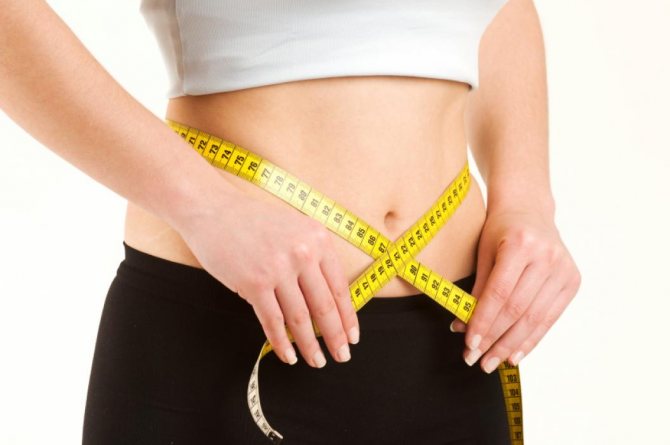
Rye bread is often used in diets
For example, in a mono-diet of black bread and water, you can get rid of a couple of extra pounds in 3-5 days. There are several options for this diet. The simplest is to eat only bread and water for several days. But such a diet caused only negative reviews.
There is a more gentle and effective option. You need to eat 3 times a day. Breakfast consists of 1 small bowl of oatmeal with water, 1 slice of rye bread and a cup of green tea without sugar. Lunch - 2 slices of bread and tea without sugar. Dinner - 2 glasses of milk and 2 slices of bread. During the day you need to drink 2 liters of water. And in the morning on an empty stomach you need to drink 1 glass of water. After this, you cannot eat for half an hour. The duration of the diet is no more than 5 days. It is not recommended to carry it out more than once every six months.
A popular diet is 7 days on rye bread, following which you can lose 6–7 kg. The menu for this diet is more varied.
Table: diet menu for 7 days
| Breakfast | Dinner | Dinner | |
| Monday | 50 g oatmeal, steamed in water or milk, 1 slice of rye bread, tea without sugar | 3 slices of rye bread, black tea without sugar | 2 slices of bread, 2 glasses of milk |
| Tuesday | 2 slices of bread, tea with milk 50/50 without sugar | 50 g oatmeal, steamed in water or milk, a glass of milk | 2 slices of bread, 2 mugs of tea without sugar |
| Wednesday | 2 glasses of water, after 20 minutes 2 slices of bread | 50 g oatmeal, steamed in water or milk | 1 slice of bread, 1 glass of milk |
| Thursday | 2 glasses of water, after 20 minutes 3 slices of bread | 2 glasses of milk, 2 slices of bread | 50 g oatmeal, steamed in water or milk, black tea without sugar |
| Friday | 50 g oatmeal, steamed in water or milk, 1 slice of bread, black tea without sugar | 50 g oatmeal, steamed in water or milk, 1 glass of water | tea without sugar, 2 slices of bread |
| Saturday | 50 g oatmeal, steamed in water or milk, 2 slices of bread, black tea without sugar | a couple of slices of bread, tea without sugar | tea without sugar, 1 slice of bread |
| Sunday | 2 slices of bread, black tea without sugar | 50 g oatmeal, steamed in water or milk, 1 slice of bread, 1 glass of water | 3 slices of bread, 1 glass of milk |
During the diet, you need to perform physical exercises that will help you effectively lose weight and tone your body.
Reviews from those who have lost weight
Hello everyone...I read about the bread diet...of course it’s interesting...Well, I lost weight differently.
In the morning I ate porridge or omelet, 1 piece of bread and butter. At lunch, a full diet of 1 and 2 and, of course, tea or compote. An afternoon snack of two mugs of kefir. In the evening, also porridge or mashed potatoes. I did not eat after 7 pm. And my food was not an ounce of salt! And I didn't drink coffee. there was meat only at lunch. I weighed 120 kg and now I’m 80. This is in 1.5 months. Now the skin is hanging on my hands... Natalch
https://edimka.ru/cgi-bin/cm.pl?r=diets_hleb
Good evening everyone, today my monthly bread diet ended, I lost 11 kg, I didn’t expect that I would just lose 5-7 kg, to be honest, I had difficulties in terms of constipation, I drank Duphalac every other day, maybe this also affected the weight loss. height 160 weight was 65 now 54.
Nyusha
https://edimka.ru/cgi-bin/cm.pl?r=diets_hleb
Rye bread for a hypoallergenic diet
Children's bodies are very weak after birth, and any product can cause allergies. And since all substances reach the baby through mother’s milk, any product eaten by the mother can become a strong allergen for the baby. In order not to harm the baby, maternity hospitals recommend that mothers follow a hypoallergenic diet.
The main task of such a diet is to avoid the appearance of rashes, itching, redness, the appearance of crusts, loose stools or, in especially severe cases, swelling of the respiratory tract due to foods and their components. Allergies may also appear later in a child.
Recent Entries
Is it possible to give a mirror: how to protect yourself from bad omens It became known about the influence of cell phone towers on human health Is it possible to eat bananas bought in Russia?
The diet divides foods into groups. Rye bread is included in the group of hypoallergenic products. It is definitely included in the menu of a nursing mother. Pediatricians classify it as a food that does not cause allergies. The amount of bread per day should be 20–30% less than the standard amount of baked goods for a healthy person. When on a diet, only 2-3 pieces per day are allowed.
Bread after 40 years
After 40 years, you need to take the foods in your daily diet most seriously in order to keep your body healthy longer and live a long life. At this age, food should be less caloric, since the body spends less energy than in youth. Priority should be given to foods with a low glycemic index. During this period, it is important to monitor bowel movements and daily bowel movements. The best assistant in this is rye bread and other fiber-rich foods. Its regular use helps to maintain normal functioning of the entire gastrointestinal tract.
Video: proper nutrition after 40 years
Summarize
- Rye bread is a great alternative to regular white wheat bread.
- Although eating it may cause bloating in sensitive people and some varieties may be high in sugar, it may have a variety of health benefits.
- It contains more fiber and nutrients, especially B vitamins, and has been linked to health benefits such as weight loss, improved blood sugar control, and improved heart and digestive health.
- Moreover, it is easy to include in your diet instead of regular white or wheat bread and can be easily prepared at home.
Rye, Bread
Health Recipes
Nowadays, there are a huge number of different variations of bread baking. But the simplest ones (with a minimum number of ingredients) are considered the best and healthiest.
Homemade rye bread from a bread machine
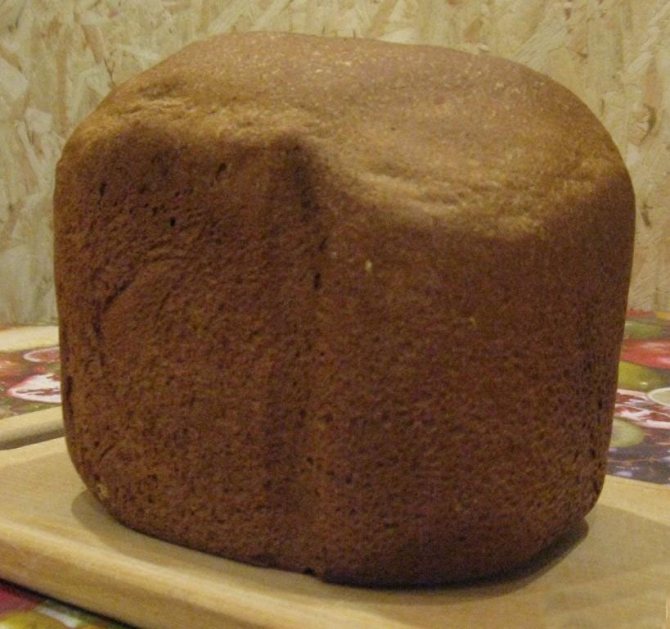
The most natural and healthy bread is homemade
Ingredients:
- rye flour - 350 g;
- high activity yeast - 1 dessert spoon;
- olive oil - 1 tablespoon;
- whey - 250 ml;
- dried cumin - 1 dessert spoon;
- salt, sugar to taste.
Recipe:
- Pour all the ingredients for the recipe into the bowl of the bread machine. Do not stir.
- Select the “Rye bread” mode and bake for 3 hours.
By cooking at home, you can adjust the acidity of the bread. To increase acidity, whey or ripe dough is added to the dough.
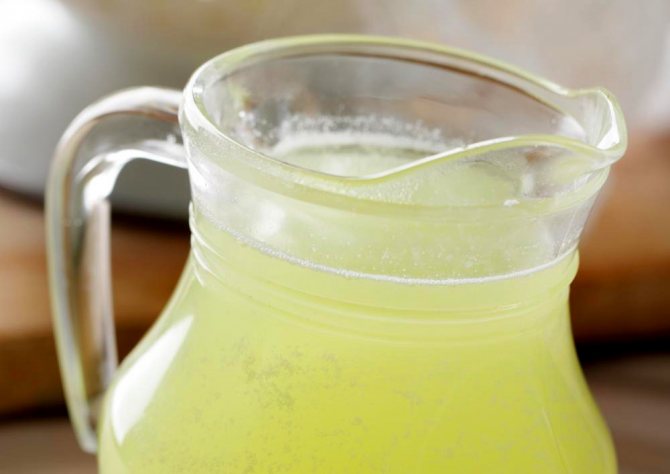
Whey serves to increase the acidity of the product
Treatment of joints and gout with rye bread gruel with kefir
Ingredients:
- Rye bread,
- kefir,
- baking soda.
Recipe:
- The bread is crushed into pieces.
- 1 glass of kefir is poured into a jar with a capacity of 500 ml and bread is added.
- 1 dessert spoon of baking soda is also added there.
- The gruel is left for 5–6 hours, then filtered and squeezed.
You need to make compresses from the resulting pulp at night. Apply to problem areas. Duration: 3–4 nights.
Yeast-free bread
This bread does not cause colic or fermentation in the intestines. It is great for almost everyone and is recommended for many diseases.
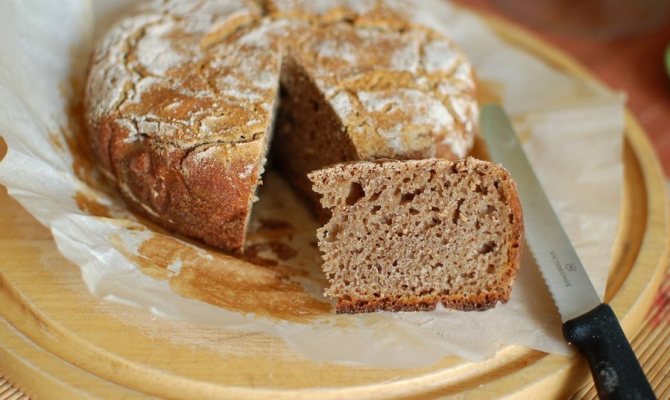
This bread does not cause bloating or heartburn.
Sourdough ingredients:
- rye flour - 100 g;
- warm water - 80 ml.
Ingredients for the dough:
- sourdough with rye flour or dough - 200 g;
- rye flour - 500 g;
- hard-brewed black tea - 140 ml;
- sugar - 1 dessert spoon;
- salt - 1 dessert spoon;
- butter to grease the baking dish.
Recipe:
- First, the dough is made. To do this, the starter is mixed with flour and water.
- The resulting dough is wrapped in film and left for 3.5–4 hours. In this case, the temperature should be 25–28 degrees.
- After time, the dough should rise. Flour, hard-boiled tea, salt and sugar are added to it.
- The dough is kneaded. It will turn out dense and sticky. You no longer need to add flour to the dough.
- The dough is again wrapped in film for 60–90 minutes at a temperature of 30 degrees.
- After the time has passed, the dough is moved with wet hands onto the table and shaped.
- After which it is transferred to a greased form and left for 35–40 minutes.
- In an oven preheated to 250 degrees, bake the bread for 10 minutes.
- After which the bread is baked for 25–30 minutes at a reduced temperature to 190–200 degrees.
Bread with honey for calluses, bones and spurs
Ingredients:
- Rye bread,
- linden honey
Recipe:
- Take a crumb of rye bread and mix it with linden honey in a 2:1 ratio.
- Before treatment, your feet need to be steamed.
- The resulting mixture is applied to the affected area and the whole thing is secured with a bandage or plaster.
- Wear for 2-3 days. Then the bandage must be removed.
If necessary, you can repeat. In 3–5 courses it is possible to get rid of even old hardened calluses.
To increase the effectiveness of treating bones and spurs, you can take baths with plantain or chamomile daily. To do this, make an infusion of herbs in the proportion of 1 liter of boiling water to 1 tablespoon of herbs. Clean feet must be steamed in this solution.
Beauty Recipes
When choosing ingredients for recipes, you should consider your skin type and hair condition.
For hair
Rye bread in hair beauty products enriches it with vitamin B, promotes hair strengthening, rapid growth, fights dandruff, improves blood circulation and helps restore the structure of the hair itself. Due to its acidity and high protein content, it makes hair more manageable and shiny. They are easier to comb and do not get tangled after washing. Systematic use of rye bread in hair recipes helps to avoid premature gray hair and preserve color and youth longer.

Rye bread improves hair condition, the effect is noticeable from the first use
Mask to activate hair growth
Rye bread needs to be poured with boiling water and left to steep for 2-3 hours. Afterwards, the bread is squeezed out, and the remaining liquid is applied to the hair roots and left for half an hour. It is better to apply to unwashed hair. After the time has passed, wash the mask off your hair with shampoo and rinse with water and a few drops of lavender essential oil. The number of repetitions for the best effect is 3 times for 5 procedures with a break of 1 month.
Rye bread shampoo
Borodino bread is best suited. We chop it into pieces and dry it. These pieces are brought to the state of crumbs in a blender. Before washing your hair, the crumbs are diluted in a small amount of water. Afterwards it is rubbed into the skin with massage movements and rinsed off generously so that there are no crumbs left in the hair.
Anti-dandruff remedy
Stale rye bread 100–150 g is poured with boiling water and kept until it becomes a paste. It is applied to the hair. Then you need to wait 30–40 minutes. The mixture is washed off with clean water. Instead of shampoo, you can use an egg or yogurt. The recommended number of procedures is 10 times.
To remove dye from hair
Kefir is mixed in equal parts with rye bread crumb and applied to the hair. You need to keep it for 1.5 hours. Afterwards it is washed off with water.
Benefits of oatmeal for skin, face, hair and digestion:
For skin
In recipes for skin beauty, cosmetologists recommend using bread crust instead of crumb, since during the cooking process it produces many antioxidants that have anti-cancer properties.

Bread face masks have been very popular for many years now among those who really care about their appearance.
Mask for oily skin
The peel of a green unsweetened apple is poured with boiling water in a volume of 150 ml. Add the rye bread crumb to the resulting mixture. Stir until you get a consistency like sour cream. Wash, cleanse and steam your face. Apply the mask along the massage lines. Keep for 15 minutes. After time, wash your face with infusion from the series. To prepare the infusion, pour 1 tablespoon of the herb into a glass of boiling water. The number of procedures is 2–3 per week. The duration of the course is 21 days.
Pore tightening mask
Soak the bread in milk until mushy. You must first cleanse your face and dry it. Apply the mask along the massage lines and hold for 20 minutes. Then rinse off with cool water. You can make a mask no more than 3 times a week.
